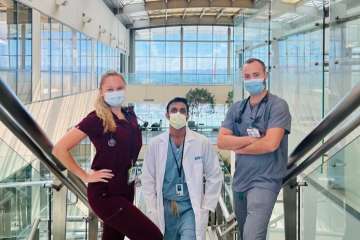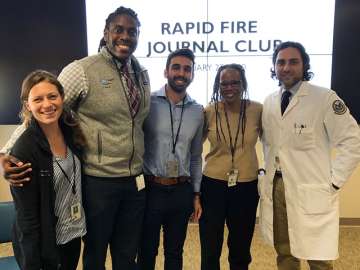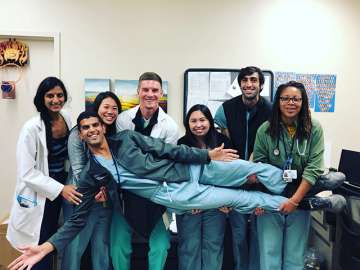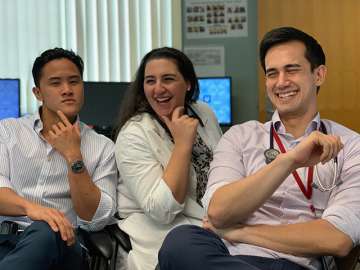Categorical
4+1 Schedule Structure
Here at UCLA, we have a long tradition of focusing a substantial amount of our subspecialty training in the ambulatory setting. In this way, trainees are exposed to a wide breadth of subspecialties that will best prepare them for a career in internal medicine. In order to continue in this tradition and to ensure residents have dedicated time for continuity clinic, we maintain a 4+1 block scheduling model for our program.

Inpatient Experience
With the 4+1 schedule, residents do not have outpatient clinic responsibilities that interrupt inpatient rotations. This also ensures maximal time when the entire inpatient team is together, improving team cohesiveness and continuity with patients. Time can be dedicated to teaching activities including pre-rounds and work-rounds, procedures, and patient-centered didactics.
Ronald Reagan General Medicine Wards
Our medicine ward team at Ronald Reagan UCLA is comprised of one resident and two interns, along with one or two medical students on their clerkship and one sub-intern. There are 6 general teams. There is an additional team consisting of one attending, one resident, one intern, and a sub-intern that has a particular teaching focus. Most attendings on our wards service are part of the UCLA hospitalist group. As the hospital is a quaternary center for many patients with organ transplants, residents become well versed in diagnosis and management of transplant-related complications, as well as common hospital conditions.
Ronald Reagan Medical Intensive Care Unit
The MICU team at Ronald Reagan hospital is comprised of two attendings, two ICU fellows, four residents, and four interns. Call is every fourth day for the resident and intern. A dedicated night team admits and takes over patient care overnight. On this service, residents become well versed in the workup and treatment of respiratory failure, pulmonary hypertension, septic shock, liver disease, gastrointestinal bleed, and other life-threatening pathology
Ronald Reagan Cardiac Care Unit
The CCU team at Ronald Reagan hospital is comprised of two attendings, two cardiology fellows, four residents, and four interns. Call is every fourth day for the resident and intern. The teams manage a combination of ICU and floor-level patients. A dedicated night team admits and takes over patient care overnight. On this service, residents learn to diagnose and manage acute cardiac pathologies such as acute coronary syndrome, heart failure, various arrhythmias, and adult-congenital heart disease.

Santa Monica Solid Oncology
The Solid Oncology service at Santa Monica hospital cares for patients with solid organ malignancies. The team is comprised of an oncology attending, an oncology fellow, two residents, and two interns. Housestaff learn the pathophysiology of common malignancies and gain competency in managing complications associated with cancer and its treatment.
Santa Monica Hospitalist
All second and third year residents rotate on the Hospitalist service at Santa Monica hospital to experience a community hospitalist practice model. This innovative rotation incorporates residents into a busy hospitalist practice and allows for growing skills toward independent practice. Residents enjoy a collegial style of supervision, working with a hospitalist attending one on one. The rotation provides seniors an opportunity to function nearly independently as community physicians.
Night Float/Night Admitting Rotation
All interns spend 2-4 weeks on night rotations as night float for general medicine wards at Ronald Reagan UCLA and the West LA VA. Interns will also be paired up with a senior resident and rotate as the night admitting intern on unit rotations (ICU or CCU). Second and third year residents participate in a 2 week rotation, alternating nights serving as the night admitting resident or night float at each of our clinical sites.
Santa Monica Geriatrics
This rotation offers exposure to a multidisciplinary geriatrics ward in a community hospital setting. The team is comprised of an attending geriatrician, two third-year residents, and a nurse practitioner. A primary objective of the rotation is to offer residents an opportunity to function as junior attendings. Another is to provide evidence-based training in geriatric medicine. The Santa Monica UCLA Geriatrics unit is a dedicated unit for care of geriatric patients with an interdisciplinary approach to patient care.
VA General Medicine Wards
The medicine ward teams at the West Los Angeles VA are made up of five traditional teams (each comprised of an attending, one resident, two interns, and at least one UCLA medical student). These teams admit on a Q5 day call schedule. Other important members of the multidisciplinary team include a case manager, social worker, clinical dietitian, and clinical pharmacist. Residents on this rotation become well-versed in diagnosing and treating common hospital conditions in a unique and underserved Veteran population who often have complex psychosocial needs.
VA Intensive Care Unit

The Medical ICU at the West Los Angeles VA is comprised of three teams, each with one resident and one intern and supervised by one attending and fellow. A dedicated night team takes over patient care overnight. Residents will gain experience managing common ICU emergencies like septic shock, respiratory failure, GI bleeds, acute coronary syndrome, among others.
VA Cardiology Telemetry Ward
The Cardiology team at the West Los Angeles VA is comprised of a cardiology attending and fellow, a senior resident, and three interns. Residents gain experience in caring for common cardiac conditions such as congestive heart failure, acute coronary syndrome, and arrhythmias.
VA Geriatrics Rotation
The VA Geriatric service is an inpatient service that admits patients over 70 years of age. The focus is on learning how to take care of geriatric patients in an inpatient setting. Teams admit patients Monday through Friday and there is no overnight call. The service consists of a board-certified geriatrician, fellow, and two senior residents.
VA Emergency Medicine Department
The VA Emergency Medicine is a busy full-service emergency department which evaluates over 33,000 patients annually, with both medical and surgical emergencies. The ED receives non-trauma related emergency ambulance traffic from the surrounding area. Interns and residents staff the ED in 9 or 10 hour shifts from 8am to midnight, and see a vast array of common diagnoses.
Olive View-UCLA Medical Center Wards
Interns will rotate at Olive View-UCLA Medical Center general medicine wards for one month during their first year. Residents may spend additional time at Olive View during their second and third years. Olive View-UCLA Medical Center is a county hospital with an underserved, primarily Spanish-speaking population.
Outpatient Experience
- Every five weeks, residents have one week dedicated to ambulatory medicine during which they see their own continuity panels and rotate through subspecialty clinics.
- Residents who have the same +1 weeks are grouped into “firms.” Residents in the same firm have the same weekends off together and get to know each other well throughout residency.
- Each +1 week includes:
- Continuity clinic
- Subspecialty clinics
- Didactic half day focusing on ambulatory medicine topics
- Simulation sessions
- Possible continuity clinic sites:
- Internal Medicine Suites at Ronald Reagan Medical Center
- West Los Angeles VA
- Sepulveda VA
- Simms-Mann Health and Wellness Center (Venice Family Clinic)
Find more information on each clinic site.

Subspecialty clinics
- Cardiology
- Endocrinology
- Gastroenterology/Hepatology
- Hematology-Oncology
- Pulmonology
- Rheumatology
- Infectious Diseases
- Palliative Care
- Women's Health
Elective rotations
- Women’s Health
- Allergy-Immunology
- East-West Medicine
- Radiology
- Dermatology
- Sports Medicine
- Sleep Medicine
- Student health
- HIV clinic
- Nuclear Medicine
- Nutrition/Obesity
- Palliative care
- Addiction medicine